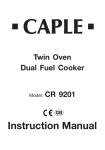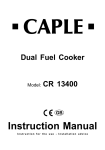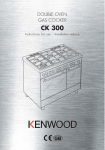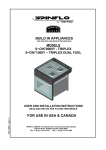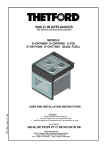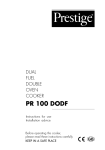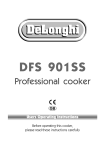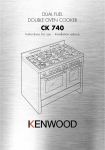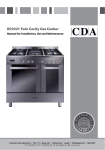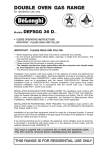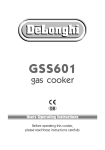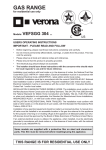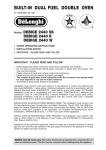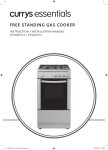Download CUM GAS/GAS PRESTIGE .2465-§9
Transcript
GAS COOKER with DOUBLE GAS OVEN PR 60 FSDOG Instructions for use Installation advice Before operating this cooker, please read these instructions carefully KEEP IN A SAFE PLACE GB Dear Customer, Thank you for purchasing a Prestige Gas Cooker with Double Gas Oven. The safety precautions and recommendations in these instructions are for your own safety and that of others. They will also provide a means by which to make full use of the features offered by your appliance. Please keep this booklet in a safe place. It may be useful in the future, either to yourself or to others in the event that doubts should arise relating to its operation. This appliance must be used only for its intended purpose , that is for the domestic cooking of foodstuffs. Any other form of usage is to be considered as inappropriate and therefore dangerous. The manufacturer declines all responsibility in the event of damage caused by improper, incorrect or illogical use of the appliance. This cooker has been designed, constructed and marketed in compliance with: - safety requirements of EEC Directive “Gas” 90/396; - safety requirements of EEC Directive “Low voltage” 73/23; - protection requirements of EEC Directive “EMC” 89/336; - requirements of EEC Directive 93/68. FIRST USE OF THE GAS OVENS Important: This appliance is designed and manufactured solely for the cooking of domestic (household) food and is not suitable for any non domestic application and therefore should not be used in a commercial environment. The appliance guarantee will be void if the appliance is used within a non domestic environment i.e. a semi commercial, commercial or communal environment. 2 Follow the instructions below for the top and the bottom ovens: – Furnish the interior of the oven by placing the wire racks as described in the chapter “ASSEMBLY AND DISMANTLING OF THE SIDE RUNNER FRAMES”. – Insert shelves and tray. – To eliminate any traces of grease on the burners: - Light the oven burner, and operate at the maximum temperature. - Light the grill burner. – Let the oven cool down and clean the interior of the oven with a cloth soaked in water and neutral detergent, then dry carefully. IMPORTANT SAFEGUARDS AND RECOMMENDATIONS After unpacking the appliance, check to ensure that it is not damaged and that the oven door closes correctly. If in doubt, do not use and consult your supplier or a professionally qualified technician. Packing materials (i.e. plastic bags, polystyrene foam, nails, packing straps, etc.) should not be left around within easy reach of children, as these may cause serious injuries. ● ATTENTION: please peel plastic cover off both sides and front of the oven before use. ● Do not attempt to modify the technical characteristics of the appliance as this may cause danger to users. ● Do not carry out any cleaning or maintenance operations on the appliance without first disconnecting it from the electric power supply. ● If you should decide not to use this appliance any longer (or decide to substitute an older model), before disposing of it, it is recommended that it is made inoperative in an appropriate manner in accordance to health and environmental protection regulations, ensuring in particular that all potentially hazardous parts be made harmless, especially in relation to children who could play with unused appliances. ● After use, always ensure that the control knobs are in the off position. ● Do not allow young children or infirm persons to use the appliance without your supervision. ● During and after use of the cooker, certain parts will become very hot. Do not touch hot parts. ● Keep children away from the cooker when it is in use. ● Some appliances are supplied with a protective film on steel and aluminium parts. This film must be removed before using the appliance. ● Fire risk! Do not store flammable material in the oven. ● Make sure that electrical cords con- ● ● ● ● ● ● ● ● ● necting other appliances in the proximity of the cooker cannot come into contact with the hob or become entrapped in the oven door. Do not line the oven walls with aluminium foil. Do not place baking trays or the drip tray on the base of the oven chamber. The manufacturer declines all liability for injury to persons or damage to property caused by incorrect or improper use of the appliance. The various components of the appliance are recyclable. Dispose of them in accordance with the regulations in force in your country. If the appliance is to be scrapped, remove the power cord. Always use oven gloves when removing the shelves and food trays from the oven whilst hot. Do not hang towels, dishcloths or other items on the cooker or its handle – as this could be a fire hazard. Clean the oven regularly and do not allow fat or oils to build up in the oven base or trays. Remove spillages as soon as they occur. Do not stand on the cooker or on the open oven door. Always stand back from the cooker when opening the oven door to allow steam and hot air to escape before removing the food. This appliance is for domestic use only. 3 1 COOKING HOB 2 2 1 3 Fig. 1.1 COOKING HOB 1. Auxiliary burner (A) 2. Semi-rapid burner (SR) 3. Triple-ring burner (TR) 1,00 kW 1,75 kW 3,50 kW Note: ✓ The electric ignition is incorporated in the knobs. 4 2 CONTROL PANEL Fig. 2.1 A 8 7 6 5 4 3 2 1 CONTROL PANEL - Controls description 1. Front right burner control knob 2. Rear right burner control knob 3. Rear left burner control knob 4. Front left burner control knob 5. Ovens light control knob 6. Top oven - Gas oven / gas grill control knob 7. Bottom oven - Gas oven control knob 8. Electronic clock/alarm NB: Your appliance has been fitted with a cooling fan to achieve optimum efficiency of the controls and to ensure lower surface temperatures are maintained. The cooling fan is thermostatically controlled and will operate when the oven is turned on and will continue to be heard running for a short period of time until the oven cavity has cooled down to a predetermined level. 5 3 USE OF COOKING HOB GAS BURNERS LIGHTING THE BURNERS Each burner is controlled by a gas tap assuring the opening and the closing of the gas supply. Make the symbols printed on the knob match the indicator on the control panel to obtain: To ignite the burner: 1) Lightly press and turn the knob anticlockwise and position the knob symbol to the indicator printed on the control panel (fig. 3.2). – symbol : off – symbol : full on (nominal rate) 2) Press the knob to operate the electric ignition; or, in the case of a mains failure light the burner with a match or lighted taper. – symbol : reduced rate 3) Adjust the burner according to the setting required. To reduce the gas flow to minimum, rotate the knob further anti-clockwise to point the small flame symbol. The maximum aperture position permits rapid boiling of liquids, whereas the minimum aperture position allows slower warming of food or maintaining boiling conditions of liquids (simmering). Other intermediate operating adjustments can be achieved by positioning the lever between the maximum and minimum aperture positions, and never between the maximum aperture and off positions. 6 Fig. 3.1 ATTENTION: the cooking hob becomes very hot during operation. Keep children away. Fig. 3.2 CHOICE OF THE BURNER On the control panel, near every knob, there is a diagram that indicates which burner is controlled by that knob. The suitable burner must be chosen according to the diameter and the capacity used. As an indication, the burners and the pots must be used in the following way: BURNERS Auxiliary POT DIAMETER 12 - 14 cm Semi-rapid 16 - 24 cm Triple-ring 26 - 28 cm Wok (*) max 36 cm CORRECT USE OF TRIPLE-RING BURNER (Fig. 3.4a - 3.4b) Flat-bottomed pans should be placed directly onto the pan-support. When using a WOK always place the supplied stand in position over the burner to maintain the correct operation of the triple-ring burner (Fig. 3.4a - 3.4b). IMPORTANT: The special grille for wok pans (fig. 3.4b) MUST BE PLACED ONLY over the panrest for the triple-ring burner. do not use pans with concave or convex bases (*): wok pans have to be used only with the special grille fitted ( see “correct use of triple-ring burner”). WRONG It is important that the diameter of the pot be suitable to the potentiality of the burner so as not to compromise the high output of the burners and therefore energy waste. A small pot on a large burner does not give you a boiling point in a shorter amount of time since the capacity of heat absorption of a liquid mass depends on the volume and the surface of the pot. Fig. 3.4a CORRECT Fig. 3.3 Fig. 3.4b 7 4 Attention: the oven door becomes very hot during operation. Keep children away. GENERAL FEATURES The oven is supplied completely clean; it is advisable, however, upon first use, to turn the oven on to the maximum temperature (position ) to eliminate possible traces of grease from the oven burner. The same operation should be completed for grill burner. TOP GAS OVEN OVEN THERMOSTAT The numbers 1 to 10 printed on the knob (fig. 4.1) indicate the increasing oven temperature value (see table below - THERMOSTAT GRADE TABLE). To regulate the temperature, set the chosen number onto the control panel indicator. The thermostat which regulates the flow of gas to the oven burner has a safety valve which automatically shuts off the gas supply when the flame goes out. The temperature is kept constant on the regulated value. The gas oven is provided with two burners: a) Oven burner, mounted on the lower part of the oven (wattage: 2,00 kW) b) Grill burner, mounted on the upper part of the oven (wattage: 2,20 kW). OVEN BURNER It carries out normal “oven cooking”. The gas flow to the burner is regulated by a thermostat which allow to maintain the oven temperature constant. The control of the temperature is assured by a thermostatic probe positioned inside the oven. The probe must be always kept in its housing, in a clean condition, as an incorrect position or encrustment may cause an alteration in the control of the temperature. Moreover, the thermostat is fitted with a safety valve which automatically shuts off the gas supply when the flame goes out. WARNING: The door is hot, use the handle. 8 Fig. 4.1 Fig. 4.2 THERMOSTAT GRADE TABLE Thermostat indicator Oven temperature 1 2 3 4 5 6 7 8 9 10 130 °C 142 °C 155 °C 168 °C 180 °C 192 °C 205 °C 218 °C 230 °C 240 °C IGNITION OF THE OVEN BURNER IMPORTANT: the oven door must be open during this operation. 1 – Open the oven door to the full extent. WARNING: Risk of explosion! The oven door must be open during this operation. 2 – Lightly press and turn the thermostat knob anti-clockwise (fig. 4.3) to max position (fig. 4.1). 3 – Press the knob right down to prime the electric ignition. Never continue this operation for more than 15 seconds. If the burner has still not ignited, wait for about 1 minute prior to repeating the ignition. In case of power cut, press the knob and immediately approach a lighted match to the opening “A” (fig. 4.4). 4 – After lighting the burner, wait a few seconds before releasing the knob (until the safety valve stays open). 5 – Gently close the oven door and set the oven control knob to the required temperature. If the flame extinguishes for any reason, the safety valve will automatically shut off the gas supply to the burner. To re-light the burner, first turn the oven control knob to position , wait for at least 1 minute and then repeat the lighting procedure. For efficient oven preheating, we recommend that grill trays and racks are removed from the oven and replaced after about 15 minutes. OVEN COOKING Before introducing the food, preheat the oven to the desired temperature. For a correct preheating operation, it is advisable to remove the tray from the oven and introduce it together with the food, when the oven has reached the desired temperature. Check the cooking time and turn off the oven 5 minutes before the theoretical time to recuperate the stored heat. A Fig. 4.3 Fig. 4.4 9 IGNITION OF THE GRILL BURNER IMPORTANT: the oven door must be open during this operation. 1 – Open the oven door to the full extent. WARNING: Risk of explosion! The oven door must be open during this operation. 2 – Lightly press and turn the thermostat knob clockwise to the position (fig. 4.5). Fig. 4.5 3 – Press the knob firmly until the burner lights. In case of mains failure, press the knob firmly and put a lighted match or taper to the pipe of the burner (fig. 4.6). Never continue this operation for more than 15 seconds. If the burner has still not ignited, wait for about 1 minute prior to repeating the ignition. 4 – After lighting the burner, wait a few seconds before releasing the knob (until the safety valve stays open). Do not close completely the oven door. The grill must always be used with the oven door slightly open and with shield "A” mounted (Fig. 4.7). The oven door must always be kept half-open and the shield "A” must be mounted when the grill is in operation. See specific instructions in the section ‘USE OF THE GRILL’. If the flame extinguishes for any reason, the safety valve will automatically shut off the gas supply to the burner. To re-light the burner, first turn the oven control knob to position ●, wait for at least 1 minute and then repeat the lighting procedure. 10 Fig. 4.6 USE OF THE GRILL OVEN LIGHT Very important: the grill must always be used with the oven door slightly open and with shield "A” mounted (Fig. 4.7). Mount shield “A” (fig. 4.7) which serves to protect the control panel from the heat. Turn on the grill, as explained in the preceding paragraphs and let the oven preheat for about 5 minutes with the door ajar. Introduce the food to be cooked, positioning the rack as close to the grill as possible. The dripping pan should be placed under the rack to catch the cooking juices and fats. The cooker is equipped with a light that illuminates the oven to enable visually controlling the food that is cooking. This light is controlled by a switch knob (Fig. 4.8 position). Note: It is recommended that you do not grill for longer than 30 minutes at any one time. Attention: the oven door becomes very hot during operation. Keep children away. WARNING: Hot part allow to cool before removing A Fig. 4.7 Fig. 4.8 11 5 BOTTOM MAIN GAS OVEN Attention: the oven door becomes very hot during operation. Keep children away. GENERAL FEATURES The oven is supplied completely clean; it is advisable, however, upon first use, to turn the oven on to the maximum temperature (position ) to eliminate possible traces of grease from the oven burner. THERMOSTAT The numbers 1 to 10 printed on the knob (fig. 5.1) indicate the increasing oven temperature value (see table 5.2). To regulate the temperature, set the chosen number onto the control panel indicator. The thermostat which regulates the flow of gas to the oven burner has a safety valve which automatically shuts off the gas supply when the flame goes out. The temperature is kept constant on the regulated value. The gas oven is provided with: – One gas burner (wattage: 3,00 kW), located at the bottom, providing safety device. OVEN BURNER It carries out normal “oven cooking”. The gas flow to the burner is regulated by a thermostat which allow to maintain the oven temperature constant. The control of the temperature is assured by a thermostatic probe positioned inside the oven. The probe must be always kept in its housing, in a clean condition, as an incorrect position or encrustment may cause an alteration in the control of the temperature. Moreover, the thermostat is fitted with a safety valve which automatically shuts off the gas supply when the flame goes out. WARNING: The door is hot, use the handle. 12 Fig. 5.1 Fig. 5.2 THERMOSTAT GRADE TABLE Thermostat indicator Oven temperature 1 2 3 4 5 6 7 8 9 10 130 °C 142 °C 155 °C 168 °C 180 °C 192 °C 205 °C 218 °C 230 °C 240 °C IGNITION OF THE OVEN BURNER IMPORTANT: the oven door must be open during this operation. 1 – Open the oven door to the full extent. WARNING: Risk of explosion! The oven door must be open during this operation. 2 – Lightly press and turn the thermostat knob anti-clockwise (fig. 5.3) to max position (fig. 5.1). 3 – Press the knob right down to prime the electric ignition. Never continue this operation for more than 15 seconds. If the burner has still not ignited, wait for about 1 minute prior to repeating the ignition. In case of power cut, press the knob and immediately approach a lighted match to the opening “A” (fig. 5.4). 4 – After lighting the burner, wait a few seconds before releasing the knob (until the safety valve stays open). If the flame extinguishes for any reason, the safety valve will automatically shut off the gas supply to the burner. To re-light the burner, first turn the oven control knob to position , wait for at least 1 minute and then repeat the lighting procedure. For efficient oven preheating, we recommend that grill trays and racks are removed from the oven and replaced after about 15 minutes. 5 – Gently close the oven door and set the oven control knob to the required temperature. A Fig. 5.3 Fig. 5.4 13 OVEN LIGHT The cooker is equipped with a light that illuminates the oven to enable visually controlling the food that is cooking. This light is controlled by a switch knob (Fig. 5.5 position). Fig. 5.5 14 6 COOKING GUIDE Temperature and times given are approximate, as they will vary depending on the quality and amount of food being cooked. Remember to use ovenproof dishes and to adjust the oven temperature during cooking if necessary. COOKING CHART Food CAKES Victoria Sandwich Small cakes/buns Rich Fruit Cake Scones Whisked Sponge BREAD & PASTRY Bread Loaf (500g Flour wt) Bread Rolls Pizza Dough Shortcrust pastry Quiches/Flans ROAST MEATS Beef – medium joint Lamb Pork Chicken Turkey Stews/Casseroles Temperature °C Gas Mark Cooking Time (approx) 180 180 150 220 190 4 4 2 7 – 8 5 20 – 25 mins 15 – 20 mins 2 hours 8 – 10 mins 25 mins 225 225 225 200 180 - 190 7 – 8 7 – 8 8 6 4 - 5 20 10 15 20 30 190 190 190 190 180 170 5 5 5 5 4 3 – – – – – 25 mins 15 mins 20 mins 30 mins 40mins 20 – 25 mins/lb + 20mins 25 – 30mins/lb + 25mins 30mins/lb + 30mins 20 – 25mins/lb + 30mins 15 – 20mins/lb + 20mins 11/2 - 2hours NOTE: Reduce the oven temperature by 10 – 20°C for fan assisted ovens. For dishes that take over an hour to cook, reduce the cooking time by 10 minutes per hour. 15 7 ELECTRONIC CLOCK/ALARM The electronic alarm is a device which groups the functions of 24 hours clock with illuminated display and 99 minutes alarm. ELECTRONIC CLOCK Upon immediate connection of the oven or after a blackout, three zeros will flash on the programmer panel. To set the hour it is necessary to push the button and then, within 7 seconds, the or button until you have set the exact hour. An energy black-out makes the clock go to zero. ELECTRONIC ALARM The alarm program consists only of a buzzer which may be set for a maximum period of 99 minutes. To set the time, push the or until you obtain the desired time in the panel. Having finished the setting, the symbol will be lighted and the countdown will start immediately. At the end of the time, the symbol will be switched off and an intermittent buzzer, during 7 minutes, will go off; this can be stopped by pressing the buttons. To stop the alarm countdown in any moment press the and buttons together and release the button first. SETTING THE FREQUENCY OF THE ALARM SOUND The selection from 3 possibilities of sound can be made by pressing the button. Fig. 7.1 16 8 CLEANING Important: Before cleaning or carrying out any maintenance disconnect the appliance from the electrical supply and wait for it to cool down. Attention The appliance gets very hot, mainly around the cooking areas. It is very important that children are not left alone in the kitchen when you are cooking. Do not use a steam cleaner because the moisture can get into the appliance thus make it unsafe. STAINLESS STEEL, ALUMINIUM PARTS AND SILK-SCREEN PRINTED SURFACES Clean using an appropriate product. Always dry thoroughly. IMPORTANT: these parts must be cleaned very carefully to avoid scratching and abrasion. You are advised to use a soft cloth and neutral soap. CAUTION: Do not use abrasive substances or non-neutral detergents as these will irreparably damage the surface. AND MAINTENANCE ENAMELLED PARTS All the enamelled parts must be cleaned with a sponge and soapy water or other non-abrasive products. Dry preferably with a soft cloth. Acidic substances like lemon juice, tomato sauce, vinegar etc. can damage the enamel if left in contact for too long. GAS TAPS In the event of operating faults in the gas taps, call the After Sales Service Department. OVEN The oven with smooth enamel must be cleaned after every use using a suitable product. Remember that operating the oven for 30 minutes on the highest temperature eliminates most grime and grease. It is mandatory not to use abrasive substances. REPLACING THE OVEN LIGHT BULB Switch the cooker off at the mains. When the oven is cool, unscrew and replace the bulb with another one resistant to high temperatures (300°C), voltage 230 V (50 Hz), 15 W, E14. Note: Oven bulb replacement is not covered by your guarantee. 17 BURNERS They can be removed and washed with soapy water only. They will remain always perfect if cleaned with products used for silverware. After cleaning or wash, check that burner-caps and burner-heads are dry before placing them in the respective housings. It is very important to check that the burner flame distributor and the cap has been correctly positioned - failure to do so can cause serious problems. CORRECT REPLACEMENT OF THE BURNERS It is very important to check that the burner flame distributor F and the cap C has been correctly positioned (see figs. 8.1 - 8.2) - failure to do so can cause a poor burner flame and/or damage to the burner and hob. Check that the electrode “S” (fig. 8.1) is always clean to ensure trouble-free sparking. Note: To avoid damage to the electric ignition do not use it when the burners are not in place. C F S Fig. 8.1 18 Fig. 8.2 TRIPLE RING BURNER The triple ring burner must be correctly positioned (see fig. 8.3); the burner rib must be enter in their lodgement as shown by the arrow. The burner correctly positioned must not rotate (fig. 8.4). Then position the cap A and the ring B (fig. 8.4 - 8.5). Fig. 8.3 A B Fig. 8.4 Fig. 8.5 19 TOP OVEN ASSEMBLY AND DISMANTLING OF THE SIDE RUNNER FRAMES – Fit the side runner frames into the holes on the side walls inside the oven (Fig. 8.6). – Slide the tray and rack into the runners (Fig. 8.7). Do not use the first level from the bottom. The shelf must be fitted so that the safety catch, which stops it sliding out, faces the inside of the oven. – To dismantle, operate in reverse order. Fig. 8.6 Do not use the first level from the bottom 20 Fig. 8.7 BOTTOM MAIN OVEN ASSEMBLY AND DISMANTLING OF THE SIDE RUNNER FRAMES – Fit the side runner frames into the holes on the side walls inside the oven (Fig. 8.8). – Slide the tray and rack into the runners (Fig. 8.9). The shelf must be fitted so that the safety catch, which stops it sliding out, faces the inside of the oven. – To dismantle, operate in reverse order. Fig. 8.8 Fig. 8.9 TOP AND BOTTOM OVENS OVEN DOORS The internal glass of the oven doors can be easily removed for cleaning by unscrewing the two lateral fixing screws (fig. 8.10). Attention: Do not store flammable material in the ovens. Fig. 8.10 21 Type A REMOVING THE OVEN DOOR To facilitate oven cleaning, it is possible to remove the door. Please follow the instructions carefully: – Open the door completely. – Push down the lever “L” and, keeping it in this position, slowly close the door in order to block the hinge. – Grip the door (as indicated in fig. 8.12) and, while closing it, release the two hinges as shown in fig. 8.13. Fig. 8.11 DOOR ASSEMBLY – Grip the door with your hands placed near the hinges and raise the levers “H” with your forefingers (fig. 8.13) – Insert the hinges in their position until levers “H” are hooked. – Open the door completely to obtain the release of levers “L”. Fig. 8.12 H 22 Fig. 8.13 Type B Fig. 8.14A REMOVING THE OVEN DOOR The oven door can easily be removed as follows: – Open the door to the full extent (fig. 8.14A). – Attach the retaining rings to the hooks on the left and right hinges (fig. 8.14B). Fig. 8.14B – Hold the door as shown in fig. 8.14. – Gently close the door and withdraw the lower hinge pins from their location (fig. 8.14C). – Withdraw the upper hinge pins from their location (fig. 8.14D). – Rest the door on a soft surface. – To replace the door, repeat the above Fig. 8.14C steps in reverse order. Fig. 8.14D Fig. 8.14 23 ADVICE FOR THE INSTALLER IMPORTANT – Cooker installation must only be carried out by QUALIFIED TECHNICIANS and in compliance with local safety standards. Failure to observe this rule will invalidate the warranty. The appliance must be installed in compliance with regulations in force in your country and in observation of the manufacturer's instructions. – Always unplug the appliance before carrying out any maintenance operations or repairs. – The surfaces of adjacent furniture and walls must be capable of withstanding temperatures in excess of 75˚C. If the cooker is installed adjacent to furniture which is higher than the gas hob cooktop, a gap of 200 mm must be left between the side of the cooker and the furniture. – Some appliances are supplied with a protective film on steel and aluminium parts. This film must be removed before using the cooker. 24 9 INSTALLATION 450 mm The furniture walls adjacent to the cooker must be made of material resistant to heat. The veneered synthetical material and the glue used must be resistant to a temperature of 90°C in order to avoid ungluing or deformations. The cooker may be located in a kitchen, a kitchen/diner or bed-sitting room but not in a room containing a bath or shower. Curtains must not be fitted immediately behind appliance or within 500 mm of the sides. It is essential that the cooker is positioned as stated below. If the cooker is located on a pedestal it is necessary to provide safety measures to prevent falling out. 750 mm This cookers has class “2/1” overheating protection so that it can be installed next to a cabinet. If the cooker is installed adjacent to furniture which is higher than the gas hob cooktop, a gap of at least 200 mm must be left between the side of the cooker and the furniture. 200 mm 500 mm Fig. 9.1 LEVELLING The cooker is equipped with a 4 levelling feet which must be fitted to the base of the cooker in the following manner: – Place the cooker on its back as shown in the figure 9.2. – Screw the 4 levelling feet to the cooker. – Stand the cooker and levelling it by screwing or unscrewing the feet. Fig. 9.2 25 STABILITY CHAIN To avoid the possibility of the cooker tipping forwards in the event of the user placing an excessive weight on the oven door when in the open position. A stability chain must be firmly fixed between the rear of the cooker and wall. PROVISION FOR VENTILATION The room containing the cooker should have an air supply in accordance with BS.5540: Part 2: 1989. All rooms require an openable window or equivalent while some rooms require a permanent vent in addition to the openable window. The cooker should not be installed in a bed-sitting room, of volume less than 21 m3. Where a DOMESTIC COOKER is installed in a room or internal space, that room or internal space shall be provided with a permanent opening which communicates directly with outside air and is sized in accordance with the table below. In domestic premises the permanent opening shall be an air vent. If there are other fuel burning appliances in the same room, BS.5540: Part 2: 1989 should be consulted to determine the requisite air vent requirements. If the cooker is installed in a cellar or basement, it is advisable to provide an air vent of effective area 100 cm2, irrespective of the room volume. MINIMUM PERMANENT OPENING FREE AREA FOR FLUELESS APPLIANCE Type of appliance Maximum appliance rated input limit Room volume < 5 m3 Domestic oven, hotplate, grill or any combination thereof. None 100 cm2 5 m3 m3 to 10 11 to > 20 m3 m3 20 m3 50 (❊) cm2 Nil cm2 Nil cm2 Openable window or equivalent also required Yes (❊) If the room or internal space containing these appliances has a door which opens directly to outside, no permanent opening is required. 26 10 GAS SECTION GAS INSTALLATION GAS CONNECTION IMPORTANT NOTE The installation of the cooker to Natural Gas or LP Gas must be carried out by a qualified gas engineer. Installers shall take due account of the provisions of the relevant British Standards Code of Practice, the Gas Safety Regulations and the Building Standards (Scotland) (Consolidation) Regulations issued by the Scottish Development Department. This appliance is supplied for use on NATURAL GAS only and cannot be used on any other gas without modification. This appliance is manufactured for conversion to LPG if required and is supplied with a conversion kit. The cooker must be installed by a qualified person in accordance with the Gas Safety (Installation and Use) (Amendment) Regulation 1990 and the relevant building/l.E.E. Regulations. The following British Standards should be used as reference when installing this appliance. BS6172 1990, BS5440 part 2 1989 and BS6891 1988. Failure to install the appliance correctly could invalidate any manufacturers warranty and lead to prosecution under the above quoted regulation. In the UK C.O.R.G.I registered installers are authorised to undertake the installation and service work in compliance with the above regulations. INSTALLATION TO NATURAL GAS Installation to Natural Gas must conform to the Code of Practice, etc. The supply pressure for Natural Gas is 20 mbar. INSTALLATION TO LP GAS This appliance must only be connected to LPG after an LPG conversion kit has been fitted, (see pages from 29 to 34). When operating on Butane gas a supply pressure of 28-30 mbar is required. When using Propane gas a supply pressure of 37 mbar is required. The installation must conform to the relevant British Standards. Warning: Only a qualified gas engineer, also with technical knowledge of electricity should install the cooker. He should observe the Regulations and Codes of Practice governing such installation of gas cookers. Note: It is recommended that the gas connection to the cooker is installed with a flexible connecting tube made to BS 5386. 27 GAS CONNECTION The gas supply must be connected to the gas inlet which is located at the left or the right hand rear of the appliance (fig. 10.1). The pipe does not cross the cooker. When screwing the connecting tube operate with two spanners (fig. 10.2). The unused end inlet pipe must be closed with the plug, interposing the gasket. After connecting to the mains, check that the coupling are correctly sealed, using soapy solution, but never a flame. Fig. 10.2 Plug 28 Fig. 10.1 The walls adjacent to the cooker must be of material resistant to heat. CONVERSION TO LPG 1 - INJECTORS REPLACEMENT OF HOB BURNERS The diameter is marked on the injector in cents of millimetre. Select the injectors to be replaced according to the “Table for the choice of the injectors” (page 31). To replace the injectors: – Remove the gratings, the burner and the covers; – Using a wrench, substitute the nozzle injectors “J” (Fig. 10.3 - 10.4) with those most suitable for the kind of gas for which it is to be used. The burners are conceived in such a way so as not to require the regulation of the primary air. J J Fig. 10.3 Fig. 10.4 29 2 - ADJUSTING OF THE MINIMUM OF THE HOB BURNERS In the minimum position the flame must have a length of about 4 mm and must remain lit even with a quick turn from the maximum position to that of minimum. The flame adjustment is done in the following way: – Turn on the burner – Turn the tap to the MINIMUM position – Take off the knob – With a small flat screwdriver turn the screw inside the tap rod to the correct regulation (fig. 10.5). Normally for LPG, tighten up the regulation screw. Fig. 10.5 30 The burners are conceived in such a way so as not to require the regulation of the primary air. TABLE FOR THE CHOICE OF THE INJECTORS GB Cat: II 2H3+ G 30 - 28-30 mbar G 31 - 37 mbar Nominal Power [kW] Reduced Power [kW] Auxiliary (A) 1,00 0,30 50 – Semirapid (SR) 1,75 0,45 65 Triple ring (TR) 3,50 1,50 95 Top oven 2,00 0,63 70 Top oven grill 2,20 – Bottom oven 3,00 0,65 BURNERS G 20 - 20 mbar Ø injectors ring opening Ø injectors ring opening [1/100 mm] [mm] [1/100 mm] [mm] 72 (X) – – 97 (Z) – – 135 (T) – 10 (*) 105 4 (*) 75 8 (*) 115 2 (*) 83 15 (*) 125 4 (*) ( ) Reference value * INCREASE OF AIR NECESSARY FOR GAS COMBUSTION (2 m3/h x kW) BURNERS Air necessary for combustion [m3/h] Auxiliary (A) 2,00 Semi-rapid (SR) 3,50 Triple-ring (TR) 7,00 Top oven 4,00 Top oven grill 4,40 Bottom oven 6,00 31 GAS OVENS (top and bottom) OPERATIONS TO BE EXECUTED FOR THE REPLACEMENT OF THE INJECTORS OF THE OVEN AND GRILL BURNERS a) oven burner Fig. 10.6 – Lift and remove the lower panel inside the oven. – Remove the burner securing screw (fig. 10.6). – Withdraw the burner as shown in figure 10.7 and rest it inside the oven. Take care not to damage the wire to the ignition electrode and the safety valve probe. Fig. 10.7 – Using a 7 mm box spanner, unscrew the injector (indicated by the arrow in fig. 10.7) and replace it by the proper one according to the kind of gas. Then replace the burner repeating the above steps in reverse order. b) grill burner (top oven only) B – Remove the burner by unscrewing the front screw B (Fig. 10.8) Gently suspend the burner as shown in figure 10.9. Be careful not to damage the wire of the electric ignition and the probe of the safety valve. Fig. 10.8 – Using a 7 mm box spanner, replace the injector (indicated by the arrow in fig. 10.9) by the proper one according to the kind of gas. Fig. 10.9 32 – Replace the burner repeating the above steps in reverse order. PRIMARY AIR OF THE OVENS BURNERS With a screwdriver untighten the screw (fig. 10.10) and move forward or backward the air flow regulation collar to close or open the air flow, according to “Table for the choice of the injectors”. Light the burner and check the flames. PRIMARY AIR OF THE GRILL BURNER (top oven only) With a screwdriver untighten the screw (fig. 10.11) and turn the air ring to close or open the air flow, according to the “Table for the choice of the injectors”. Light the burner and check the flames. Fig. 10.11 Ring opening Fig. 10.10 Ring opening 33 Flame faulty in primary air Flame correct Flame with excess primary air long, yellow and trembling clear interior blue cone short and sharp too blue interior cone tending to detach correct distance of the tube This needs to be done only for the oven burner (the grill is a fixed capacity) by acting on the thermostat in the following way: – turn on the burner by setting the thermostat knob on position 10 CAUSE air regulating tube, too closed ADJUSTMENT OF THE OVENS BURNERS MINIMUM air regulating tube, too open Flame correct Flame faulty in primary air Flame with excess primary air – remove the knob and unscrew the bypass screw (fig. 10.12) about three times by passing a small flat screwdriver (Ø 3 mm blade, 100 mm length) through the panel opening – re-mount the knob and let the oven heat up for about 10 minutes, then bring the knob to position 1 (minimum) to operate the thermostat by-pass – after having removed the knob again and being very careful not to turn the tap rod, slowly screw the by-pass screws “G” (fig. 10.12) until you obtain a flame of 3-4 mm in height. N.B. For G30/G31 the by-pass screw must be fixed thoroughly. LUBRICATION OF THE GAS TAPS G If a tap becomes stiff, do not force; contact your local Service Agent. IMPORTANT All interventions regarding installation maintenance of the appliance must be fulfilled with original factory parts. The manufacturer declines any liability resulting from the non-compliance of this obligation. 34 Fig. 10.12 11 ELECTRICAL SECTION For your safety please read the following information: This appliance must be installed by a qualified technician according with the current local regulations and in compliance with the manufacturer instructions. This appliance has to be equipped with a 13 amp three pin mains plug with a 3 amp fuse fitted. Should the fuse require replacement, it must be replaced with a fuse rated at 3 amp and approved by ASTA or BSI to BS 1362. The plug contains a removable fuse cover that must be refitted when the fuse is replaced. In the event of the fuse cover being lost or damaged, the plug must not be used until a replacement cover has been obtained. Replacement fuse covers can be purchased from your nearest electrical dealer and must be the same colour as the original. IF THE MAINS PLUG IS UNSUITABLE FOR THE SOCKET OUTLET IN YOUR HOME OR IS REMOVED FOR ANY OTHER REASON, THEN THE FUSE SHOULD BE REMOVED AND THE CUT OFF PLUG DISPOSED OF SAFELY TO PREVENT THE HAZARD OF ELECTRIC SHOCK. THERE IS A DANGER OF ELECTRICAL SHOCK IF THE CUT OFF PLUG IS INSERTED INTO ANY 13 AMP SOCKET OUTLET. If a replacement plug is to be fitted, please observe the wiring code shown below. Warning! This appliance must be earthed 3 amp fuse Green & Yellow Earth A properly earthed three pin plug (fused at 3 amps, to BS 1362 ASTA approved) must be used. As the colours of the wires in the mains lead of this appliance may not correspond with the coloured markings identifying the terminals in your plug, proceed as follows. The wire which is coloured GREEN & YELLOW must be connected to the terminal in the plug which is marked with letter "E" or by the Earth symbol or coloured GREEN & YELLOW. Blue Neutral Brown Live Fig. 11.1 The wire which is coloured BLUE must be connected to the terminal which is marked with the letter "N" or coloured BLACK. The wire which is coloured BROWN must be connected to the terminal which is marked with the letter "L" or coloured RED. 35 Warning! Before effecting any intervention on the electrical parts the appliance must be disconnected from the network. REPLACEMENT OF THE ELECTRICAL FEEDER CABLE – Remove the two screws securing the cover plate A behind the cooker. – Remove the screw C from the cable clamp. – Insert the feeder cable of the suitable section (as described in the next chapter) into the cable protector D. – Connect the phase and earth cables to the mains terminal connection block B. N L EARTH NEUTRAL LIVE – Refit the cable clamp so that it clamps the outer sleeving of the cable. – Refit the cover plate A. FEEDER CABLE SECTION - type H05RR-F 230 V 3 x 0,75 mm2 B Green &Yellow (Earth) L N Brown (Live) C A Blue (Neutral) Fig. 11.2 36 P Your Prestige from COMET Your new Prestige product comes with 12-month guarantee covering all parts and labour. If your appliance proves to be defective as a result of faulty materials or workmanship during the guarantee COMET will repair or replace it free of charge. AFTER SALES SERVICE Should you require to book a service call. Please Telephone 08705 425425. For product information and advice. Please Telephone 0113 2793520. 1. The right and benefits under this guarantee are additional to your statutory rights, which are not affected by this guarantee. 2. COMET undertakes within the specified period, to repair or replace free of charge any parts of the appliance found to be defective provided this: • We are promptly informed of the defect • The appliance is installed and used in accordance with the written instructions enclosed with the appliance • The appliance is used only on an electrical supply as indicated on the rating label fixed to the appliance • The appliance has not been altered in any way or subject to misuse or repair by a person other than an authorised service agent for COMET 3. No rights are given under this guarantee to a person acquiring the appliance second hand or for commercial or communal use. 4. This guarantee applies throughout the UK Channel Islands. 5. Any replaced parts shall be the property of COMET 6. Any repaired or replacement appliances will be guaranteed on these terms for the unexpired portion of the guarantee. IMPORTANT INFORMATION FOR CORRECT DISPOSAL OF THE PRODUCT IN ACCORDANCE WITH EC DIRECTIVE 2002/96/EC. At the end of its working life, the product must not be disposed of as urban waste. It must be taken to a special local authority differentiated waste collection centre or to a dealer providing this service. Disposing of a household appliance separately avoids possible negative consequences for the environment and health deriving from inappropriate disposal and enables the constituent materials to be recovered to obtain significant savings in energy and resources. As a reminder of the need to dispose of household appliances separately, the product is marked with a crossed-out wheeled dustbin. 37 38 Descriptions and illustrations in this booklet are given as simply indicative. The manufacturer reserves the right, considering the characteristics of the models described here, at any time and without notice, to make eventual necessary modifications for their construction or for commercial needs. 39 Prestige® is a registered trademark of Meyer Intellectual Properties Limited and is sold pursuant to a license. code 1102465 ß9








































